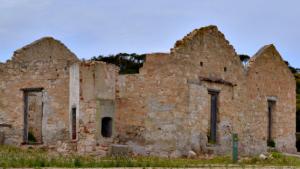Category: Landscape Photography

Post Type:
Photography
Mixed Media: None | Resized for FAR
Pays
one point
and 2 member cents.





© Copyright 2024. Zilyram All rights reserved.
Zilyram has granted FanStory.com, its affiliates and its syndicates non-exclusive rights to display this work.
Posted: November 4, 2011
Pages:
...7 -8- 9... 
      |
Now a ghost town once gypsum mining town
A chapter in the book South Australia
Ruins at Inneston
by Zilyram
Interested in this? Contact The Artist
The township of Inneston developed as a mining settlement following the discovery of gypsum in the early 1900s, by William Robert Innes, after whom the mining village and the National Park are named.
Gypsum, a mineral used as in ingredient for plaster, was sought after for building construction and the manufacture of plaster mouldings. At first the gypsum was shipped to Melbourne from Marion Bay for processing, and eventually the processing was undertaken at the extraction site.
At the peak of its mining operations the population of the township reached about 500, but over time averaged approximately 150. As the settlement was so isolated from other larger service towns, it was necessary for Inneston to be fully self sufficient, and the town had its own school, post office, bakery and general store, plus an oval for cricket.
The town was wholly sustained by the demand for gypsum, and by 1970 Inneston had become a ghost town as mining operations ceased. Today the partially restored, heritage listed Inneston village provides an excellent insight into the mining history of the region.
by Zilyram Interested in this? Contact The Artist
Gypsum, a mineral used as in ingredient for plaster, was sought after for building construction and the manufacture of plaster mouldings. At first the gypsum was shipped to Melbourne from Marion Bay for processing, and eventually the processing was undertaken at the extraction site.
At the peak of its mining operations the population of the township reached about 500, but over time averaged approximately 150. As the settlement was so isolated from other larger service towns, it was necessary for Inneston to be fully self sufficient, and the town had its own school, post office, bakery and general store, plus an oval for cricket.
The town was wholly sustained by the demand for gypsum, and by 1970 Inneston had become a ghost town as mining operations ceased. Today the partially restored, heritage listed Inneston village provides an excellent insight into the mining history of the region.
Mixed Media: None | Resized for FAR


Ruins at Inneston
by Zilyram

You need to login or register to write reviews. It's quick! We only ask four questions to new members.
© Copyright 2024. Zilyram All rights reserved.
Zilyram has granted FanStory.com, its affiliates and its syndicates non-exclusive rights to display this work.

